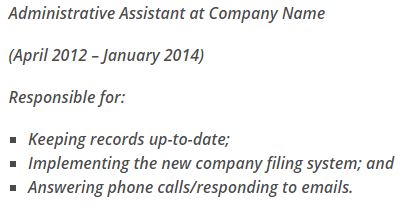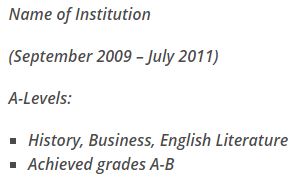Personal statement
Your personal statement is one of the most important aspects of your CV. It’s where you give an overview of who you are and inject a touch of personality. You should tailor it to every job you apply for, highlighting specific qualities that match you to the role. Aim to keep your personal statement short and sweet, and no longer than a few sentences.
To make the most of this section, you should try to address the following:
- Who are you?
- What can you offer the company?
- What are your career goals?
Experience and employment history
This section gives you a chance to outline your previous jobs, internships, and work experience. Your experience should be listed in reverse chronological order. You should state your job title and the dates you worked, followed by your responsibilities. It helps to choose the duties most relevant to the job you’re applying for, especially if it’s a long list.
You can experiment with the format, but in this section, bullet points are useful for clarity and highlighting key skills.
Below is a very basic example, but you should take this chance to showcase your strongest areas and your achievements in previous positions.

Education
Like the Experience section, your education should be listed in reverse chronological order. Include the name of the institutions and the dates you were there, followed by the grades you achieved. If you have a lot of qualifications, there’s no need to list them all; just choose the most relevant. If you have a degree, you could list a few of the most relevant modules you took.
Bullet points are useful in this section, too. For example:

Achievements
You might look at this section and think you have no achievements, but achievements don’t have to be formal awards. If you’ve done anything you’re particularly proud of, like completing a project or receiving a promotion, you can and should include it.
It’s only going to help the recruiter build a picture of you and your successes, so don’t worry about what qualifies as an achievement — if you’re proud of it, let them know.
Hobbies and interests
You don’t need to state your hobbies and interests on your CV, but they help recruiters know more about your personality. If you have any interesting hobbies that make you shine, or if your hobbies relate to the industry you’re going into, you can use this section to build a bigger picture of you as a person.
If you’re running low on space, don’t worry too much; just remember that, if worded well, this section could really make you stand out.
References
Your referees should be your previous employers or your educational tutors, but there’s no need to list all their details in this section. A person’s name, physical address, contact number, and email address are common things to include. Something like the following is fine:
Taufeeq Ahmad (Head of Sales)
Sales Company LTD
23 Multan Road
LAHORE
Or, you can save space by simply stating:
References available upon request.
Recruiters can then ask for more information if and when they need it.